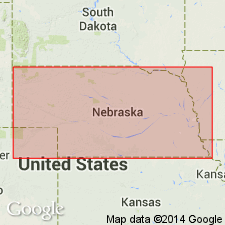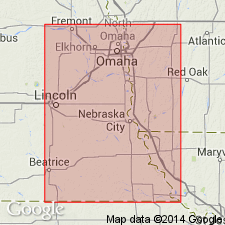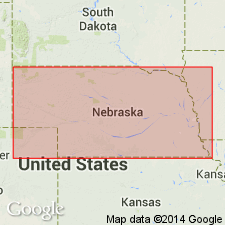
- Usage in publication:
-
- South Bend limestone member
- Modifications:
-
- Original reference
- Dominant lithology:
-
- Limestone
- AAPG geologic province:
-
- Nemaha anticline
Summary:
Pg. 7, 23. South Bend limestone member of Braddyville formation. Exposed in bed of Salt Creek southwest of Chicago, Burlington and Quincy RR station at Ashland, at track level near mouth of Salt Creek, in valley sides from Pawnee Creek to Louisville, and from State Fish Hatcheries to Meadow. Thickness 8 to 9 feet. Along railroad 0.5 mile east of Pawnee Creek it shows: light-gray limestone, 10 inches; light-colored shale with calcareous concretions, 1 foot 3 inches; light-gray limestone, 2 feet 10 inches; light bluish gray shale, 1 foot 10 inches; limestone with large flint nodules, 2 feet 6 inches. Lies 6 to 10 feet above Louisville limestone and 16 to 18 feet below Ashland limestone. [Pl. 2 shows the limestone exposed in cliff at South Bend, Cass Co., southeastern NE.] Fossiliferous (fusulinids, brachiopods). Age is Pennsylvanian. Report includes measured sections, cross sections.
Source: US geologic names lexicon (USGS Bull. 896, p. 2030); GNC KS-NE Pennsylvanian Corr. Chart, sheet 1, Oct. 1936; supplemental information from GNU records (USGS DDS-6; Denver GNULEX).

- Usage in publication:
-
- South Bend limestone bed
- Modifications:
-
- Principal reference
- Revised
- AAPG geologic province:
-
- Nemaha anticline
Summary:
Pg. 41, 58. South Bend limestone bed of Scranton shale member of Shawnee formation. Is 9 feet thick, is in lower part of Scranton shale. It overlies Rock Lake shale and underlies Plattford shale. Age is Late Pennsylvanian (Missouri age). Report includes cross sections, measured sections, geologic maps, stratigraphic tables.
Named from exposures just north of South Bend [Cass Co., southeastern NE].
Source: US geologic names lexicon (USGS Bull. 896, p. 2030); GNC KS-NE Pennsylvanian Corr. Chart, sheet 1, Oct. 1936; supplemental information from GNU records (USGS DDS-6; Denver GNULEX).

- Usage in publication:
-
- South Bend limestone bed
- Modifications:
-
- Revised
- AAPG geologic province:
-
- Nemaha anticline
Summary:
Pg. 11, 18, 27, 32. In Ashland section what was supposed to be South Bend limestone is Iatan limestone. The South Bend limestone underlies Weston shale and overlies Rock Lake shale and is top bed of Stanton limestone member. Described from measured sections along Platte River, Cass Co., southeastern Nebraska. Has been traced into Missouri and Kansas. Fossils. Age is Pennsylvanian.
[This definition adopted by R.C. Moore and Condra in their Oct. 1932 revised classification chart of Pennsylvanian rocks of Nebraska and Kansas.]
Source: US geologic names lexicon (USGS Bull. 896, p. 2030); GNC KS-NE Pennsylvanian Corr. Chart, sheet 1, Oct. 1936; supplemental information from GNU records (USGS DDS-6; Denver GNULEX).
For more information, please contact Nancy Stamm, Geologic Names Committee Secretary.
Asterisk (*) indicates published by U.S. Geological Survey authors.
"No current usage" (†) implies that a name has been abandoned or has fallen into disuse. Former usage and, if known, replacement name given in parentheses ( ).
Slash (/) indicates name conflicts with nomenclatural guidelines (CSN, 1933; ACSN, 1961, 1970; NACSN, 1983, 2005, 2021). May be explained within brackets ([ ]).

